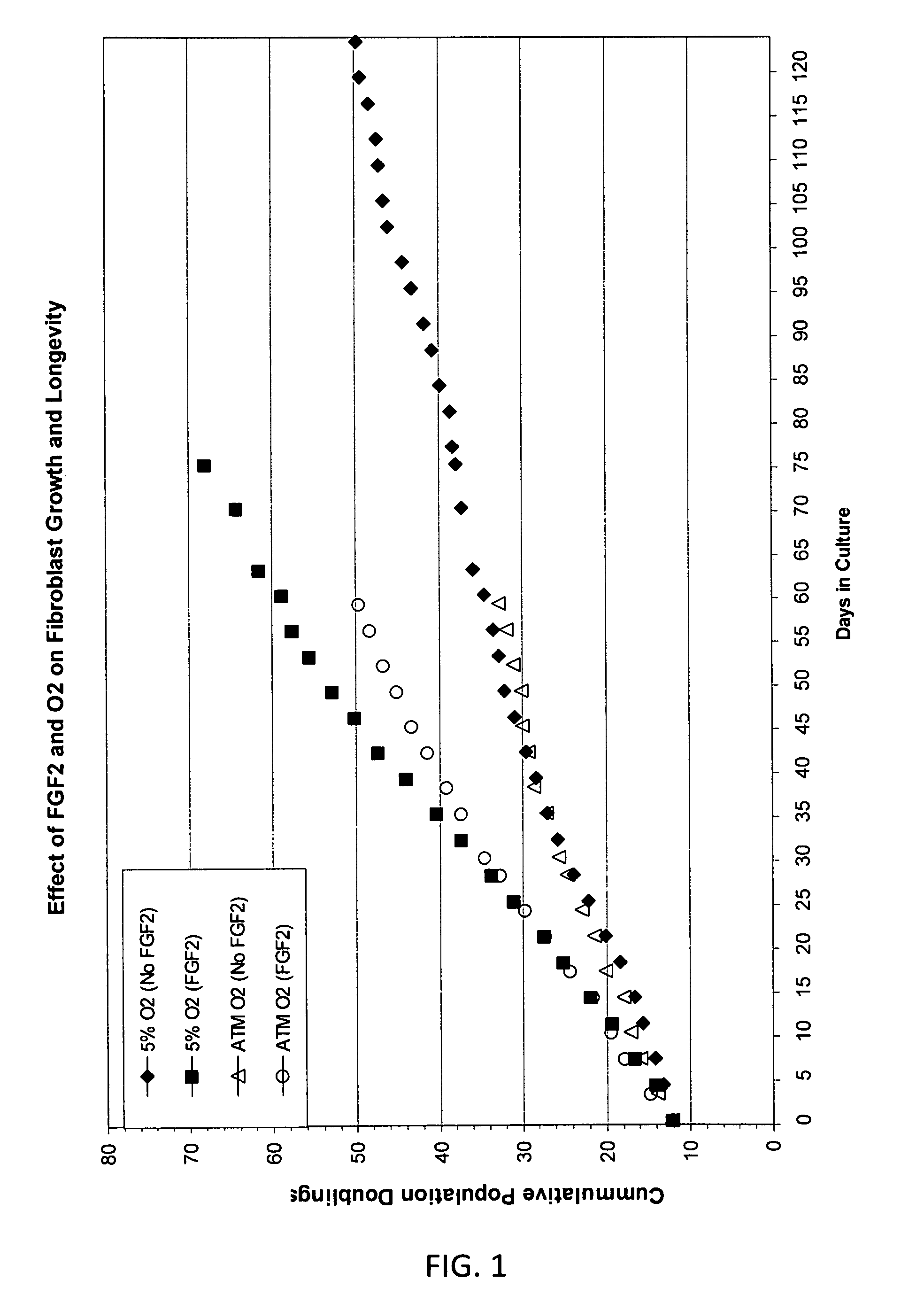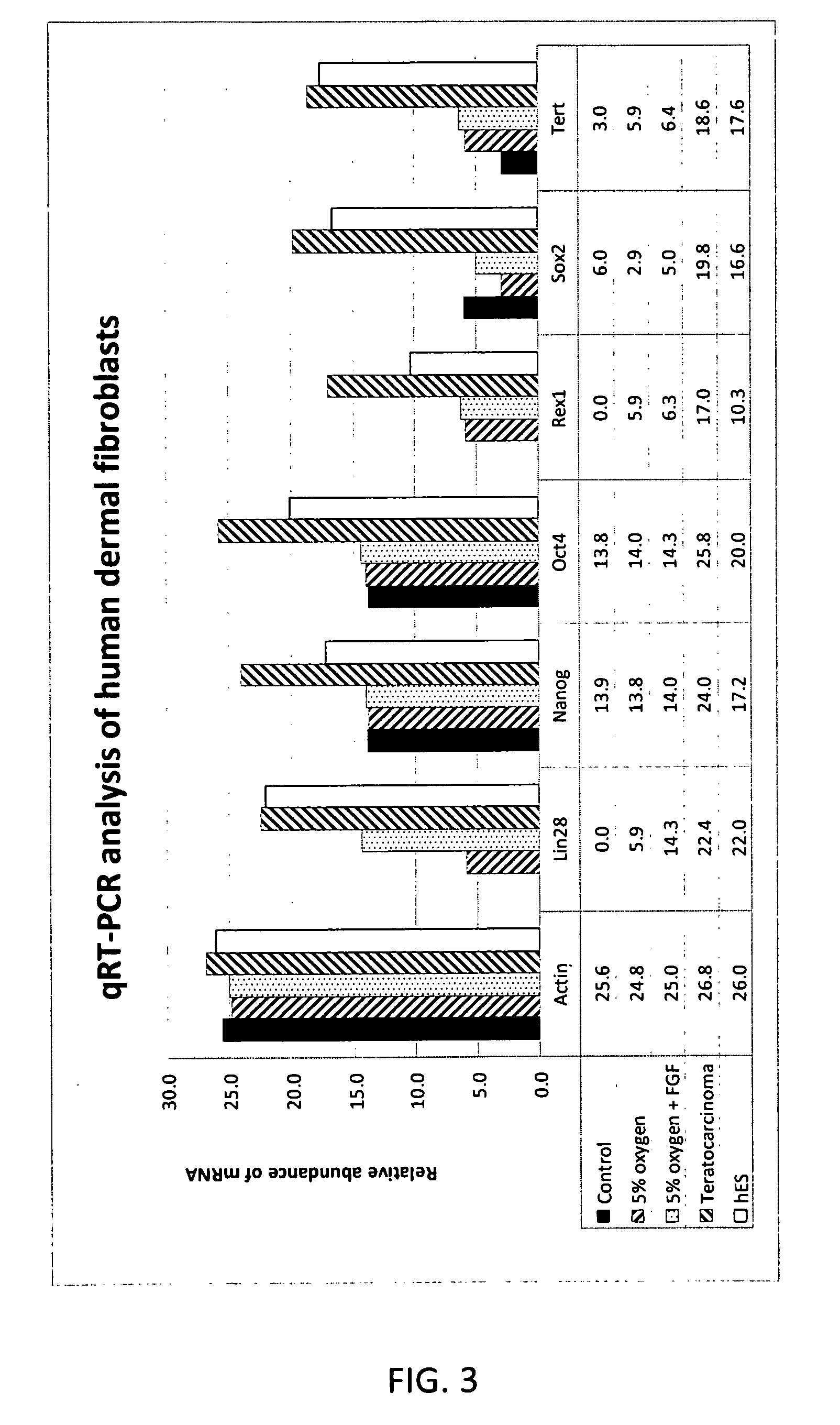Novel use of basic fibroblast growth factor in the de-differentiation of animal connective tissue cells
a technology of fibroblast growth factor and connective tissue cells, which is applied in the direction of skeletal/connective tissue cells, extracellular fluid disorders, metabolic disorders, etc., can solve the problems of limited in vitro lifespan, inefficient and limited de-differentiation protocols to achieve pluripotent cells, and use of growth factors and culture conditions to increase cell culture proliferation rates with limited success
- Summary
- Abstract
- Description
- Claims
- Application Information
AI Technical Summary
Benefits of technology
Problems solved by technology
Method used
Image
Examples
example 1
Methods
[0057]Adult human fibroblasts (cell line CRL-2352) derived from connective tissue isolated from tissue derived from a below knee amputation of a 24 year old male were received from American type Tissue Culture Collection (ATCC) (Manassas, Va.) as cryopreserved vials and were stored in liquid nitrogen until use. Cells were thawed at 37 C and added dropwise to 10 ml of basal culture medium (CM-1A, 45% DMEM without L-gln or phenol red (MediaTech, Manassas, Va.) with 4 mM L-Gln (MediaTech), 45% Hams F12 Medium (MediaTech), and 10% Fetalclone III (Hyclone, Logan, Utah)). The cell suspension was centrifuged at 700×g for 5 min, the medium aspirated and the pellet resuspended in fresh CM1A culture medium. Cells were seeded at a density of 0.5×106 in 10 ml of medium in T75 tissue culture flasks (BD Falcon). Cultures were carried out in a 37 C incubator in a humidified environment of 5% CO2, 5% O2, 90% N2. Cells were passaged at routine intervals at approximately 70-90% confluence usin...
example 2
Methods
Cell Culture
[0064]Primary adult human dermal fibroblasts from connective tissue isolated from tissue biopsy from a below knee amputation of a 24 year old male were received from ATCC(CRL-2352) at passage 2. Cells were cultured in medium consisting of DMEM:Ham's F12 (60:40, MediaTech) with 10% Fetalclone III (Hyclone, Logan, Utah). The DMEM (without L-Gln or phenol red) was supplemented with 4 mM fresh L-Gln (MediaTech) prior to use. Cultures were carried out in a 37° C. incubator in a humidified environment of 5% CO2, 5% O2, and 90% N2. The number of population doublings calculated as log2. Cells were seeded at 100,000 cells per T25 flask at each passage (Falcon). When used, human recombinant FGF2 (Chemicon or Protide) and BMP-2 (R&D Systems) was supplemented into medium at 4 ng / ml and 1 ng / ml respectively. Human muscle derived fibroblasts were derived from surplus muscle tissue from the calf flexor muscle used for a surgical knee repair in a 59 year old adult male. Tissue wa...
PUM
| Property | Measurement | Unit |
|---|---|---|
| concentration | aaaaa | aaaaa |
| concentration | aaaaa | aaaaa |
| concentration | aaaaa | aaaaa |
Abstract
Description
Claims
Application Information
 Login to View More
Login to View More - R&D
- Intellectual Property
- Life Sciences
- Materials
- Tech Scout
- Unparalleled Data Quality
- Higher Quality Content
- 60% Fewer Hallucinations
Browse by: Latest US Patents, China's latest patents, Technical Efficacy Thesaurus, Application Domain, Technology Topic, Popular Technical Reports.
© 2025 PatSnap. All rights reserved.Legal|Privacy policy|Modern Slavery Act Transparency Statement|Sitemap|About US| Contact US: help@patsnap.com



